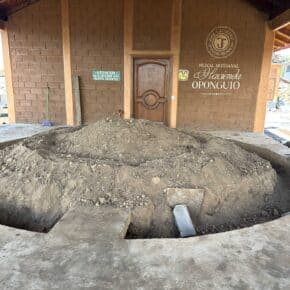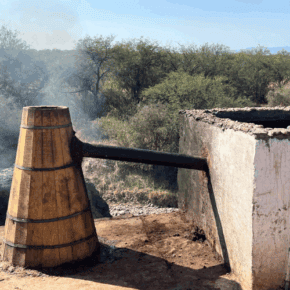
NOTE: I edited this piece slightly because a sharp eyed commenter noted that diffusors are explicitly allowed, a fact that I flat out missed while reading and translating the NOM. I’m going to be writing more about that in the coming days but for now I’m just updating this post with the relevant information.
— Max Garrone
—-
Ever so quietly NOM 70 was passed into Mexican law on February 23nd. This after years of debate and discussion – a process that was unusual for its inclusiveness and for how the voices of the people impacted by the law are included in it. Now that we have a law it’s time to figure out what it means. Here’s the full text.
Big picture: Many producers are thrilled because NOM 70 achieves most of what they wanted. Many were even surprised that it survived relatively undiluted. That says quite a bit about the strengths of Hipocrates Nolasco who was able to maneuver it into place.
One of the big surprises is that diffusers are explicitly permitted. This makes the industrial level mezcal category, “Mezcal,” mean that it can contain pretty much anything and follows the tequila model. That sets the stage for lots of consumer confusion and future struggles about how to define the term mezcal, capitalized or not.
The big take away for lovers of mezcal is that there are now three terms that define your favorite agave distillate:
Mezcal
- Roast: Agave hearts or juice cooked in any of the following – underground stone ovens, above ground masonry ovens, or autoclaves.
- Crush: Any of the following methods: By hand, with a tahona, with Chilean or Egyptian mills, with a crusher or shredder, continuous mill, or diffusors.
- Fermentation: In wood or concrete or stainless steel tanks.
- Distillation: In alembique or continuous still or copper or stainless steel column stills.
Mezcal Artesanal
- Roast: Agave hearts in an underground stone oven or above ground masonry oven.
- Crush: By hand or with a tahona or Chilean or Egyptian mills or crusher or shredder.
- Fermentation: In any of the following; stone, earth, wood, clay, animal skins. Agave fibers must be included.
- Distillation: Must happen with direct fire on a copper alembique or a clay pot still. Agave fibers must be included.
Mezcal Ancestral
- Roast: Agave hearts in an underground stone oven
- Crush: One of the following; by hand, with a tahona, a Chilean or Egyptian mill
- Fermentation: One of the following; stone, earth, wood, clay, animal skins. Agave fibers must be included.
- Distillation: Must happen with direct fire on a clay pot still. Agave fibers must be included.
But what does it all mean?
To break it down for you, anything called “Mezcal Ancestral” really is a hard core traditional mezcal, only mezcal made with clay pot stills qualifies. This represents a tiny number of the distilleries in Mexico, and even then mostly in Oaxaca, so don’t expect to see much of this soon. The sad thing is that this excludes all the other still types that have been used for generations if not all the way back to the origin of mezcal. This excludes many mezcaleros that really should be classified as Ancestral, especially in states outside of Oaxaca.
Then there’s “Mezcal Artesanal,” the vast middle of the mezcal world. Basically this encompasses most of the mezcal brands on the US market right now and much of what we loosely classify as traditional. It’s a grab bag classification that basically says, ‘if you’re doing things the traditional way, we’ll give you this label.’ The one point that some people take exception to is that you can use a shredder or mechanical crusher and still be called Mezcal Artesanal. Obviously these tools weren’t around before the 20th Century but they do save mezcaleros back breaking work and many of them, including some of the most respected in the business, claim that it doesn’t change the flavor. We’ll be doing some tastings to see if we can tell the difference soon.
And then there’s “Mezcal,” yeah, we call it mezcal with out the quotation anyway and that’s the major complaint with this category – any Tom, Dick, or Harry mezcal producer can slap this label on their brand when they’re using industrial methods to produce it. Hell, they don’t even have to roast the hearts of agave, they can cook the “jugos de maguey” which literally translates to “agave juice” so you can crush or shred the agave, render the pulp and then cook it. And you can use a diffuser which means that the CRM is allowing the same sort of production methods that have really diluted brand tequila. This is going to be an issue for brand mezcal, tequila has devoted notable marketing resources to addressing the issue but ti remains the existential issue for that spirit.
What’s in the law, what’s not?
The larger point is that given that we now have legislation it’s very easy to pick at what’s explicitly defined. It’s just as easy to wonder why things aren’t included. We can label these things as quirks – until they become trends. That use of “jugos de maguey” is one example, another is the evolution of the term “agave” over the history of the legislation. Previous versions basically erased the term “agave” from the law in favor of the term “maguey.” In one previous version the word “agave’ was exorcised from the proposal except in this quote “Maguey is any species of agave.” For the rest of that draft the term “maguey” was used to refer to the plant and its components. The fact that the version that passed into law doesn’t have this line and uses agave and maguey freely and interchangeably may say something about the evolution of the CRM in the wake of the debate over NOM 199.
Another little quirk is that the final law doesn’t mention yeast which is surprising given that wild yeasts contribute so much to the flavor mezcal. This could mean nothing but it’s hard to tell. Given the centrality of wild yeasts to traditional mezcal, it certainly feels like you’d want to limit the addition of commercial yeast strains to the industrial “Mezcal” label and make that clear to consumers. Earlier versions of the law at least mentioned yeast even if they didn’t have any guidance on how it is to be used. This level of speculation is just part of law making, once you define something you have to pay attention to what’s included as well as what’s left out.
Now what? We have questions into the CRM about what’s supposed to happen when and will report back as soon as we hear anything. Given how long lead times are for batches it doesn’t feel like change will happen tomorrow but we are pursuing this line of questioning and will report back as soon as we are able to get comment.
The NOM 199 postscript
Let’s not forget about NOM 199 – We haven’t heard hide nor tail of that for some time so we’re not really sure what to think about it. It’s perfectly possible that it’s off whimpering away in a cave until it dies a solitary death. It’s also perfectly possible that it will quietly become law at some point meaning that what’s called mezcal will suddenly change. We have clear thoughts on this shared by many, hopefully those will be taken into consideration.












Great article, although one point about the diffusor: The reform states they just have to cook the juice of the agave rather than the whole agave hearts, which sounds to me to mean that Casa Armando GP (Zignum, Recuerdo de Oaxaca, El Seniorio) can use their diffusor in it’s present form (crushing raw hearts then boiling juice) rather than adapting it, no?
I know Casa Armando wouldn’t have let the use of their diffusors be restricted without a fight – They sent a whole platoon of lawyers to the first consultations back in 2014!
That’s a huge question and why I said technically you can’t use a diffuser. It may come down to how you define what a diffuser is…
Someone mentioned this on twitter, diffuser is mentioned in “Molienda” part of Norma, which makes sense as this type of equipment is used in conjunction with an autoclave “Cocción”. So diffuser is allowed
Hi Tom, It’s a bit more complex than that. By name the diffuser isn’t allowed, but like I say citing the legislation, you’re allowed to cook “jugos de maguey” which leaves room for something like a diffuser. But there’s also the enforcement element of this legislation and the follow on elements so we’ll see how that plays out.
Again look at the Norma. Guessing you really don’t know about this equipment. Notice in section b says difusor?
4.4.1. Mezcal.
Su elaboración debe cumplir con al menos las siguientes cuatro etapas y equipo:
a) Cocción: cocimiento de cabezas o jugos de maguey o agave en hornos de pozo, mampostería o autoclave.
b) Molienda: tahona, molino chileno o egipcio, trapiche, desgarradora, tren de molinos o difusor.
c) Fermentación: recipientes de madera, piletas de mampostería o tanques de acero inoxidable.
d) Destilación: alambiques, destiladores continuos o columnas de cobre o acero inoxidable.
Hi Tom,
Wow, I can’t believe that I missed that. I do know about the equipment, I just flat out missed that. This is pretty major.
Max
Thank you for summarizing this for your readers. Haven’t read the whole document yet but I’m curious if there are rules around label information. Label info is usually a good indicator of how “artesanal” the product might be; hopefully they won’t allow mezcals to be distributed that claim to be “artesanal” without listing production info on the bottle.
Mezcal Vago does a great job of labeling their bottles. I noticed that Gracias a Dios recently tweaked their label to highlight the word “handmade” and put their mezcalero’s name front and center. The flipside of this is that brands can likely print things on their bottle without any oversight in an attempt to trick buyers. Will be interesting to see how this plays out.
Yes, there is quite a bit of instruction as to what can, and must, be on labels. But it’s different from the Vago idea, more along lines of emphasizing the key ideas in NOM 70. I’ll try to summarize this soon because I understand exactly what you’re saying.
Hey Max,
Thanks for this – I’m clearly late to the party this time!
One major mistake here: the “artesanal” category does _not_ in fact require bagazo be included in fermentation or distillation. It is merely _allowed_. See below (emphasis added).
“c) Fermentación: oquedades en piedra, suelo o tronco, piletas de mampostería, recipientes de madera o barro, pieles de animal, cuyo proceso PUEDE incluir la fibra del maguey o agave (bagazo).
d) Destilación: con fuego directo en alambiques de caldera de cobre u olla de barro y montera de barro, madera, cobre o acero inoxidable; cuyo proceso PUEDE incluir la fibra del maguey o agave (bagazo).”
Wow….the ancestral category also does not require bagazo in fermentation or distillation.
Does this NOM 70 change the adage of “all tequila is a type of mezcal, but not all mezcal is a tequila”?
Or is that nonsense to begin with? Would appreciate some mezcal experts help!
That’s a good question, my reflexive answer is that it doesn’t change the major definitional terms. The question of if and when something ceases to be a mezcal doesn’t seem to change with NOM 70 but the rise of aguardientes and destilados de agave forced by regulatory trends may be something bigger.